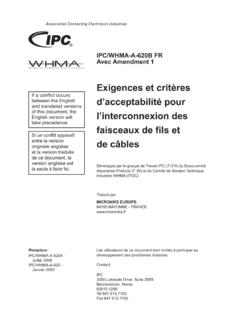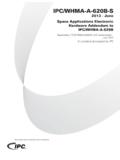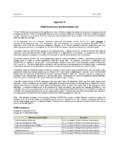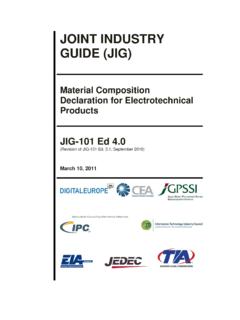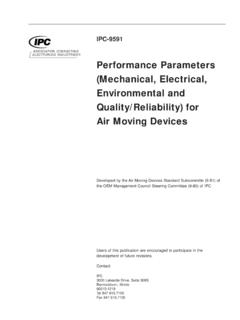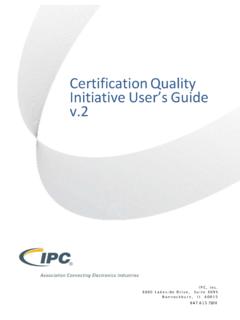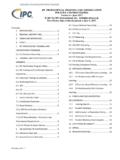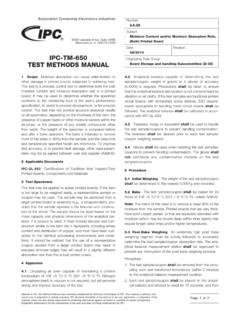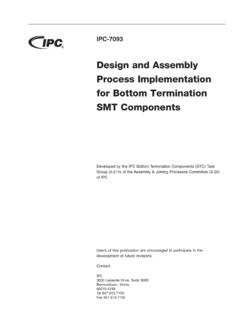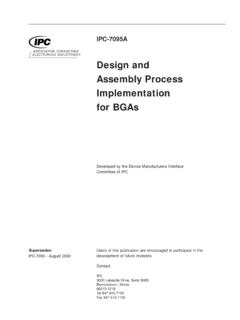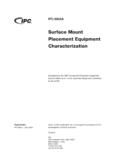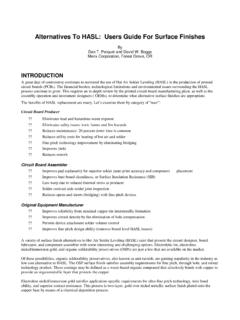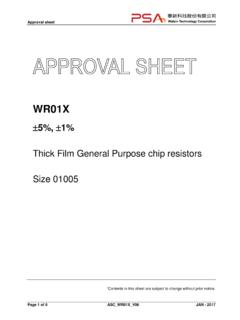Transcription of ELECTRONICS INDUSTRIES Monotonic Bend Characterization …
1 IPC/JEDEC-9702 Monotonic BendCharacterizationof board -LevelInterconnectsDeveloped by the SMT Attachment Reliability Test Methods Task Group(6-10d) of the Product Reliability Committee (6-10) of IPC and theJEDEC Reliability Test Methods for Packaged Devices Committee( )Users of this publication are encouraged to participate in thedevelopment of future :IPC2215 Sanders RoadNorthbrook, Illinois60062-6135 Tel 847 847 State Technology Association2500 Wilson BoulevardArlington, VA 22201-3834 Tel 703 703 CONNECTINGELECTRONICS INDUSTRIES Table of 14 TERMS AND 15 SYMBOLS AND ABBREVIATED Tester .. Measurement Equipment .. Monitoring Equipment .. Sample .. board Material .. board Thickness and Metal Layer Count .. board Surface Finish .. board Land Pads .. board Layout .. board Daisy-Chain Links .. Assembly.
2 Strain Gages .. Set-Up Test board .. Four-Point bend Test .. 69 FAILURE CRITERIA AND 7 ANNEX 9 ANNEX 12 FiguresFigure 7-1 Universal Tester .. 2 Figure 8-1 Test board Layout .. 4 Figure 8-2 Rectangular Package Orientation .. 5 Figure 8-3 Single Package Daisy-Chain Configuration(Example) .. 5 Figure 8-4 Strain Gage Placement .. 7 Figure 9-1 interconnect Fracture Modes (SolderBall Array Devices) .. 8 Figure Example Configuration (PWB Thickness= mm) .. 9 Figure Example Configuration (PWB Thickness= mm) .. 10 Figure Example Configuration (PWB Thickness= mm) .. 11 TablesTable 7-1 Universal Tester Requirements .. 2 Table 8-1 Recommended TestBoard Thickness & Layer Count .. 3 Table 8-2 Test board Layout Requirements .. 4 Table 8-3 Monotonic bend Test Requirements .. 7 Table Test Report Recommendations(Equipment & Materials).
3 12 Table Test Report Recommendations( board Assembly) .. 12 Table Test Report Recommendations(Test Results) .. 12 IPC/JEDEC-9702 June 2004ivMonotonic bend Characterizationof board -Level Interconnects1 FOREWORDThis publication on Monotonic bend testing is intended tocharacterize the fracture strength of a component s board -level interconnects. The document is applicable to surfacemount components attached to printed wiring boards usingconventional solder reflow technologies. The monotonicbend Characterization results provide a measure of fractureresistance to flexural loading that may occur during con-ventional non-cyclic board assembly and test operations,and supplements existing standards that address mechani-cal shock or impact during shipping, handling or INTRODUCTIONS emiconductor devices are assembled in a variety of pack-age configurations, and are used in a multitude of applica-tions.
4 Given the diversity of package constructions andend-use conditions, it is not feasible to establish a singlequalification requirement relating to bend testing; however,definition of a uniform test methodology and a standardreliability Characterization reporting process are increas-ingly necessary to ensure adequate product SCOPEThis publication specifies a common method of establish-ing the fracture resistance of board -level device intercon-nects to flexural loading during non-cyclic board assemblyand test operations. Monotonic bend test qualification pass/fail requirements are typically specific to each device appli-cation and areoutsidethe scope of this TERMS AND DEFINITIONSFor the purposes of this standard, the selected terms anddefinitions listed below TermsComponent:Packaged semiconductor deviceInterconnect:Conductive element used for electricalinterconnection, , solder ball, lead, Test:Non-reversing, test to failStrain Related TermsGlobal PWB Strain:Four-point bending strain of uniformprinted wiring board , ignoring any effects due to the pack-age(s)Microstrain:Dimensionless unit, 106x (change in length) (original length)Strain:Dimensionless unit, (change in length) (originallength)Strain-Rate:Change in strain divided by the time intervalduring which this change is measuredStrain Gage.
5 Planar copper foil pattern that is adhered toan underlying surface and exhibits a change in resistancewhen subjected to a strainStrain Gage Element:Sensing area of strain gage definedby the serpentine copper grid patternUniaxial Strain Gage:Strain gage incorporating a singlestrain gage element, , capable of detecting strain along asingle axisMechanical Test Equipment TermsAnvil:Four-point assembly fixture support with a roundedcontact surfaceCrosshead Assembly:Clamping/attachment assembly ofuniversal tester that moves relative to the base of the testequipment, and creates the forces necessary for specimentestingFour-Point Bending Fixture:Test assembly that supports aspecimen on two anvils or rollers, and symmetrically loadsthe specimen on the opposite surface with two anvils orrollersLoad Span:Distance between the two anvils or rollersthat load the test specimenRoller:Four-point assembly fixture support that incorpo-rates a cylindrical bar as the contact surfaceSupport Span:Distance between the two anvils or rollersthat support the test specimenUniversal Tester:Test equipment capable of tensile/compressive loading using controlled linear motion of acrosshead assemblyElectrical Test TermsDaisy-Chain:A conductive link that can be connected inseries with other conductive links (like a chain of daisies)to form a continuous electrical netIn-Situ Measurement:Measurement conducted during atest, , in place, rather than during an interruption of thetest conditionFailure Analysis TermDye-and-Pry:Dye exposure of package/ board assemblyfollowed by mechanical removal of the packageJune 2004 IPC/JEDEC-97021
